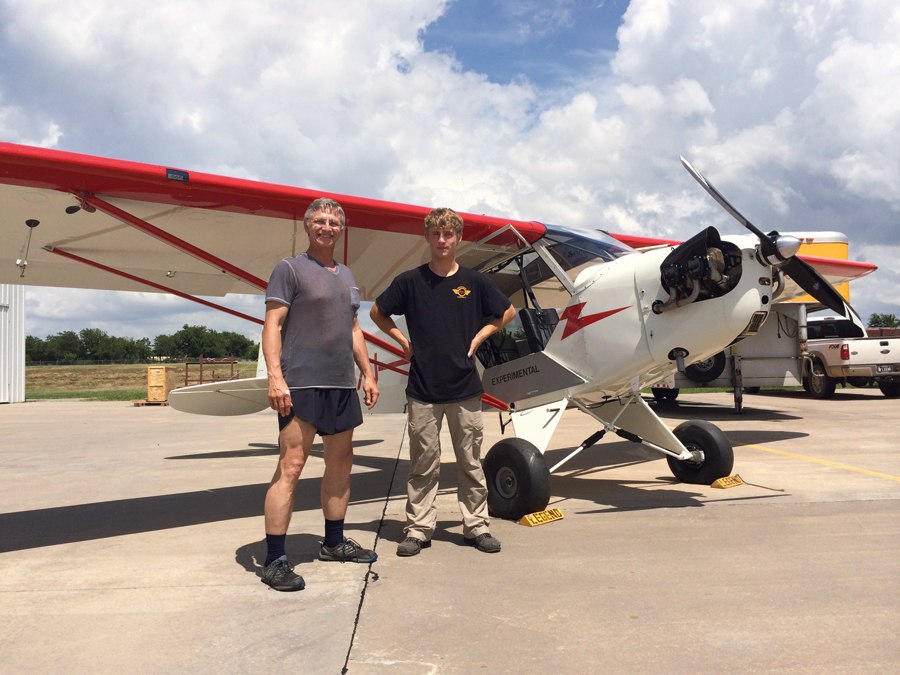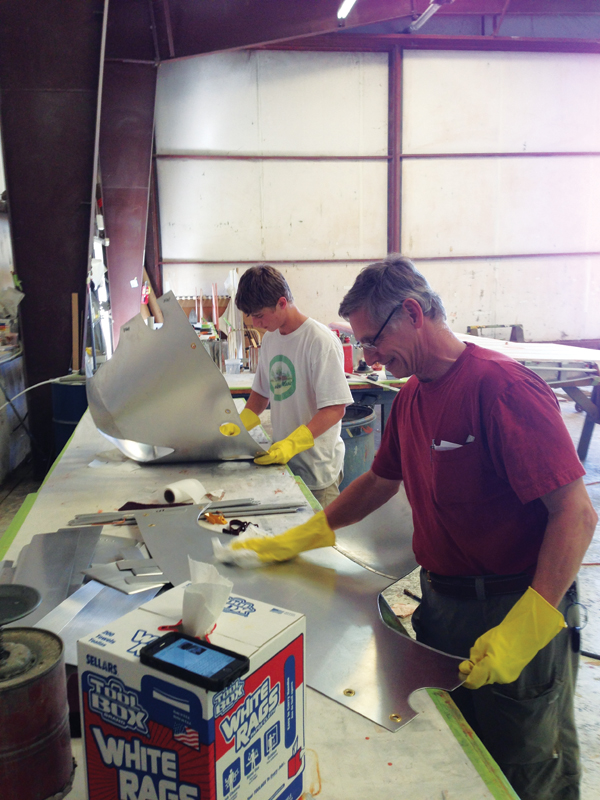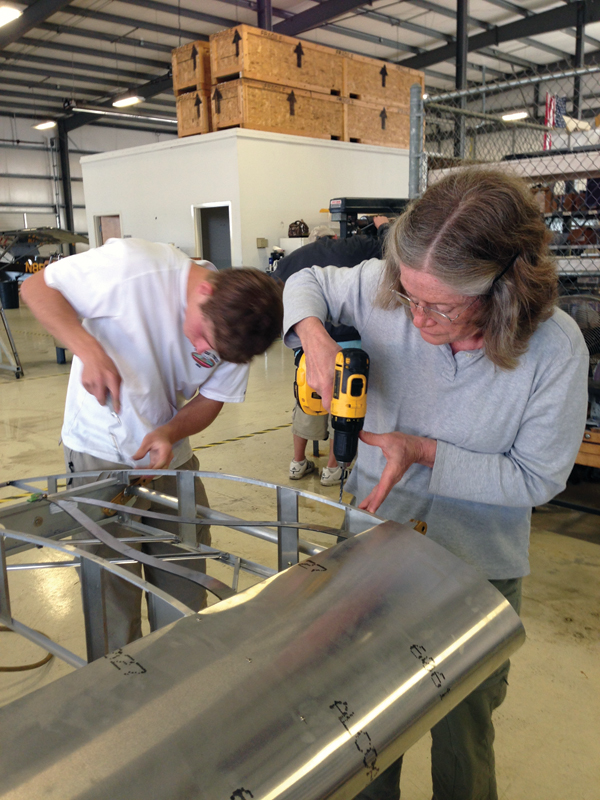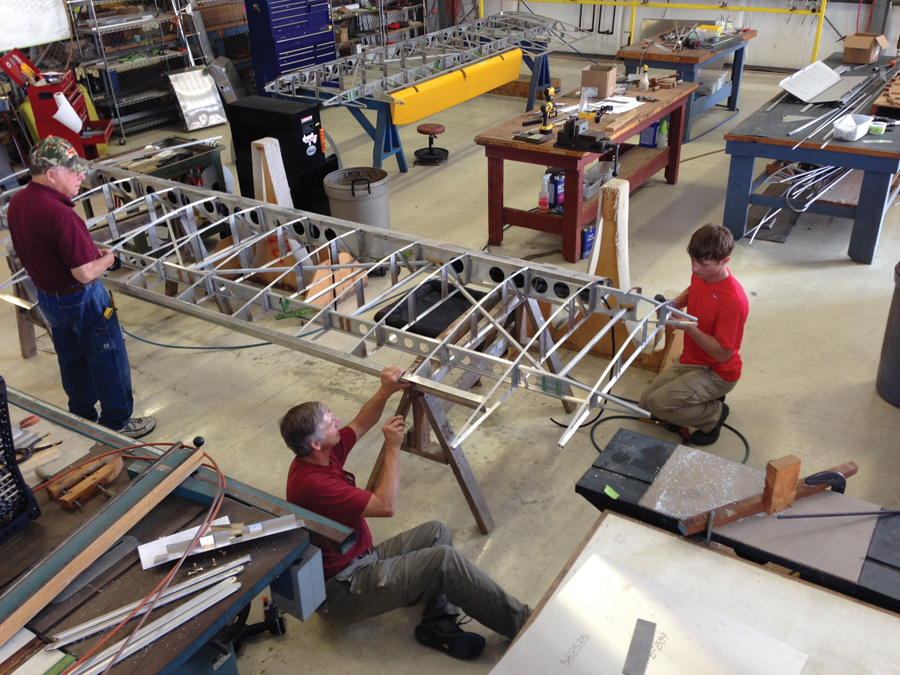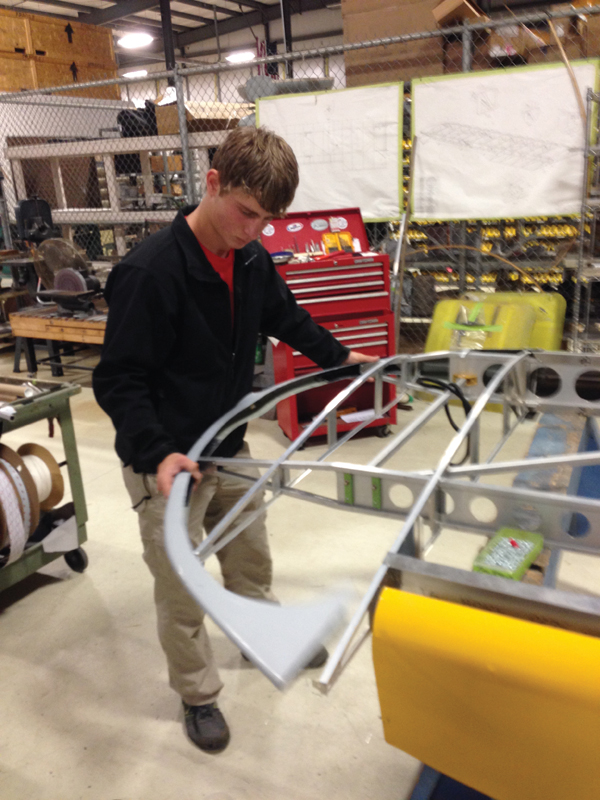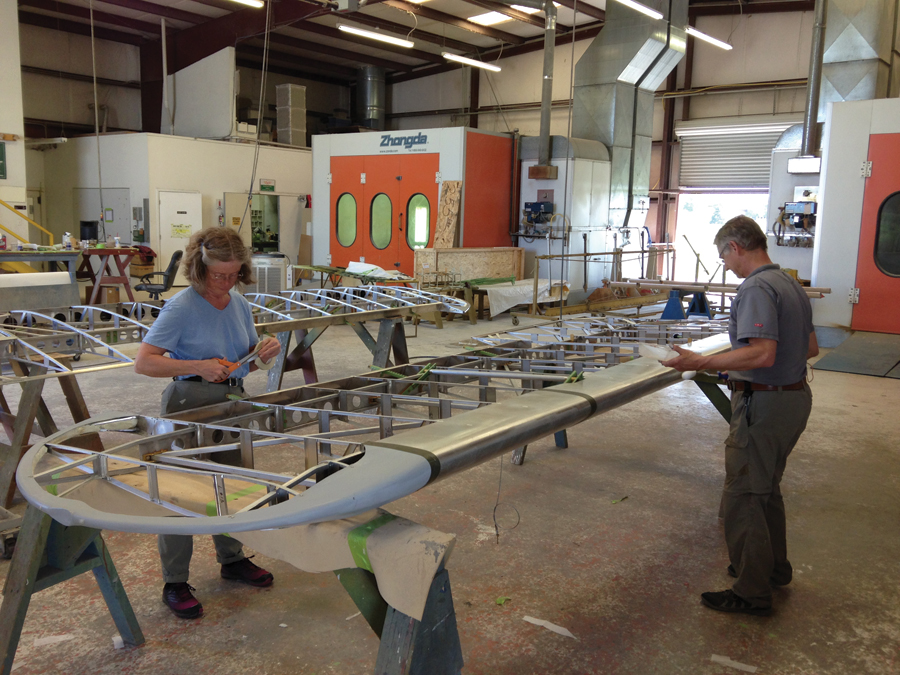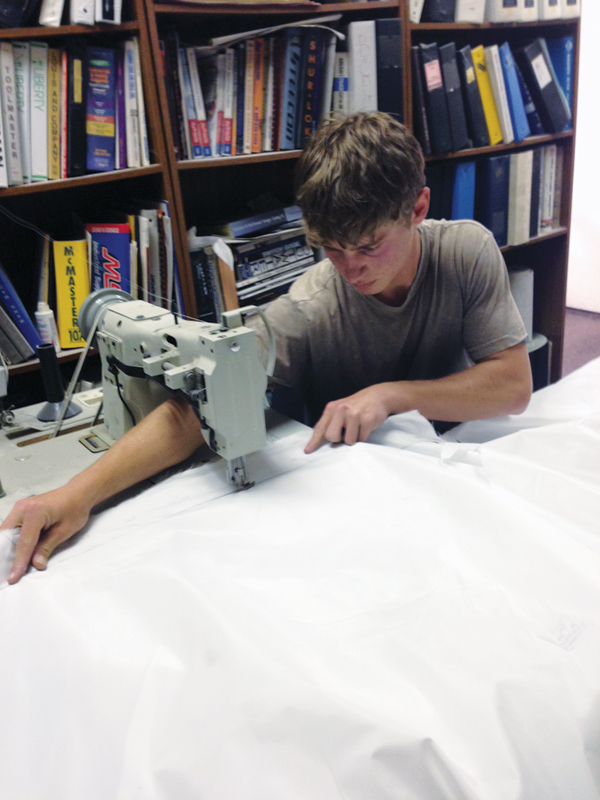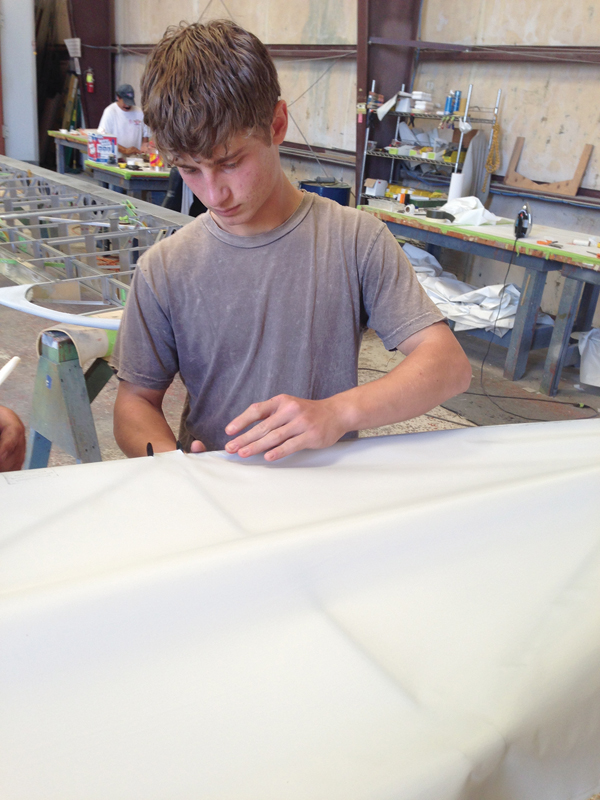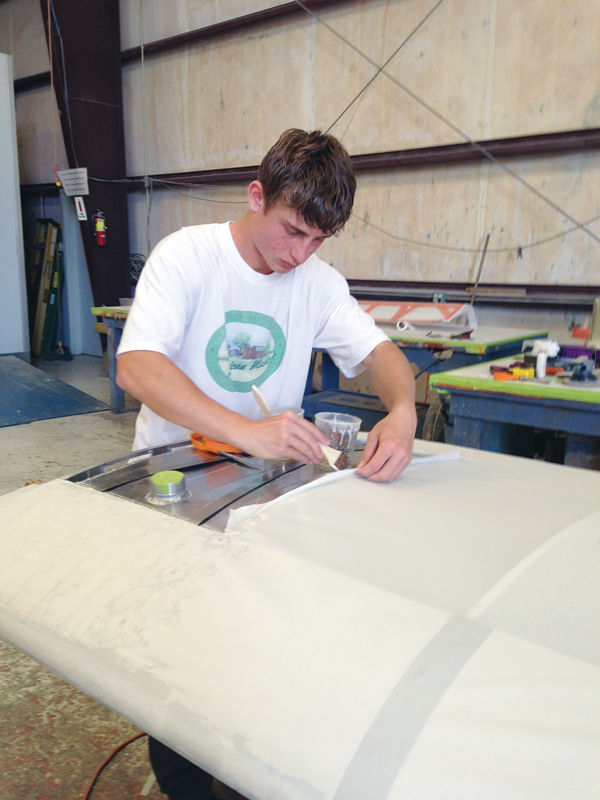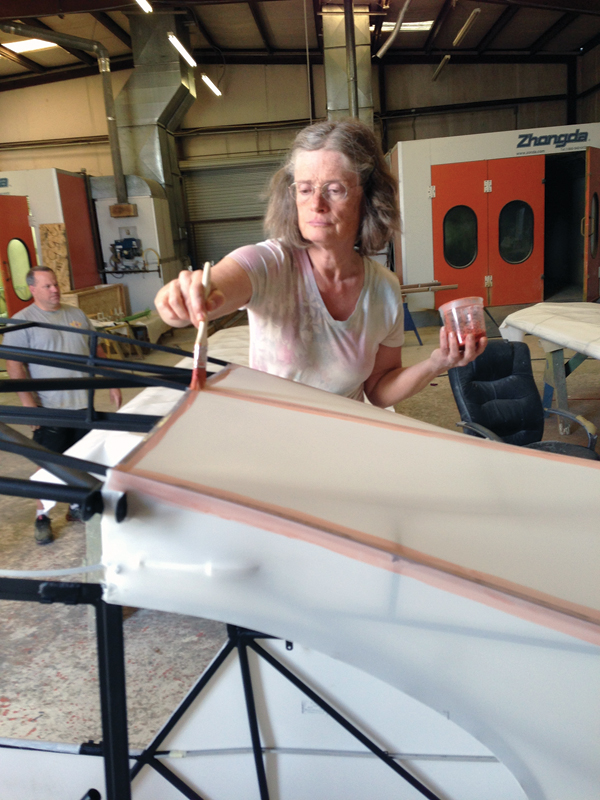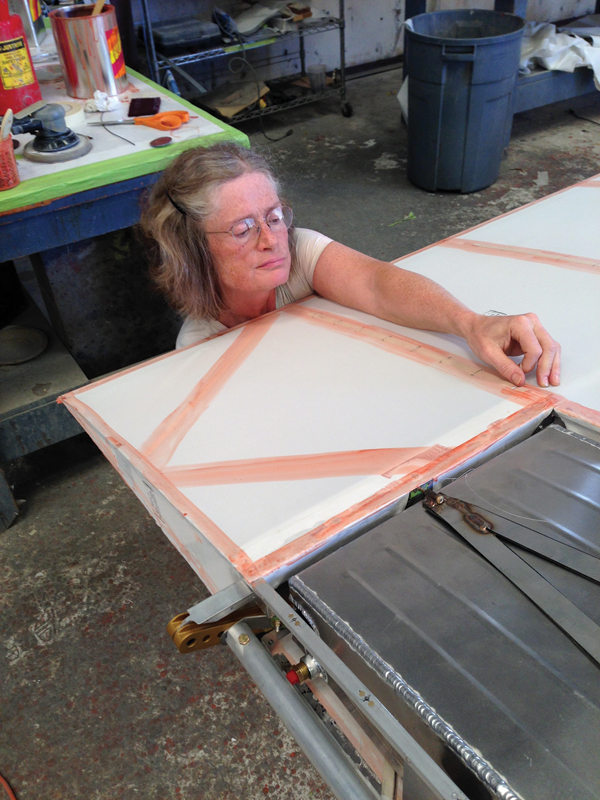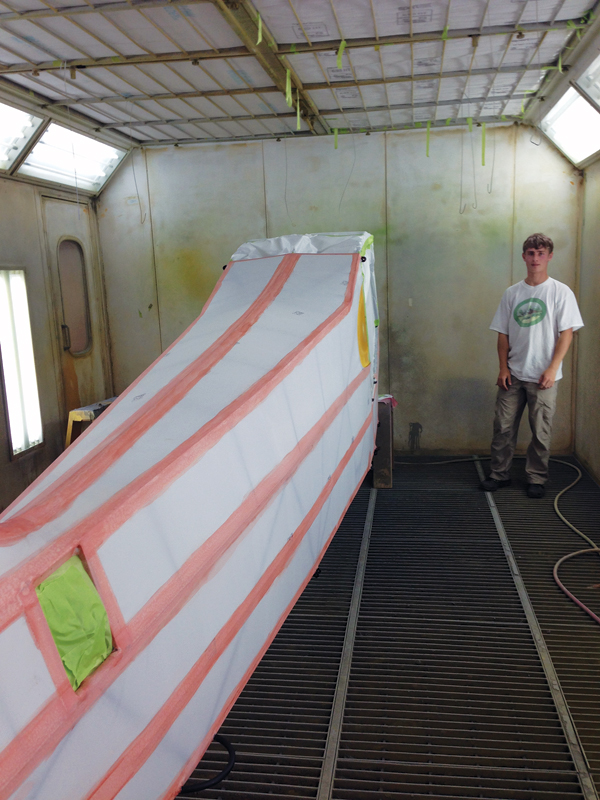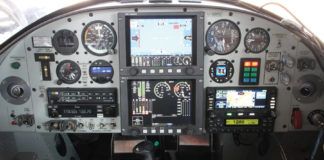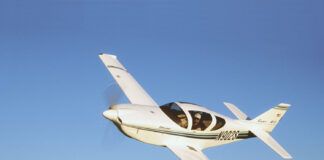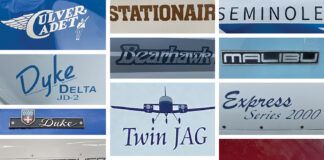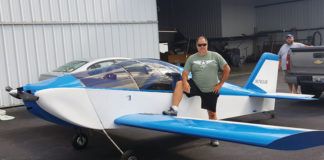John Takacs of Portland, Oregon, spent a week at American Legend Aircraft Company in Sulphur Springs, Texas, before I got a chance to speak with him about building his Legend Cub. He assured me the project was a family affair. His wife had come out to help over a weekend, offering expertise with stitching the fabric covering. “She leaves tonight,” stated John. He and his son, John Paul, would stay four more days. “We will be doing a few modifications to the build,” he added.
Both John and his wife Joan are physicians. John has a family practice, while Joan is a specialist in physical medicine. At 17 years of age, John Paul and his father have been building balsa wood airplanes for many years. John Paul flies radio-controlled aircraft competitively. Last year he represented the United States in a world competition.
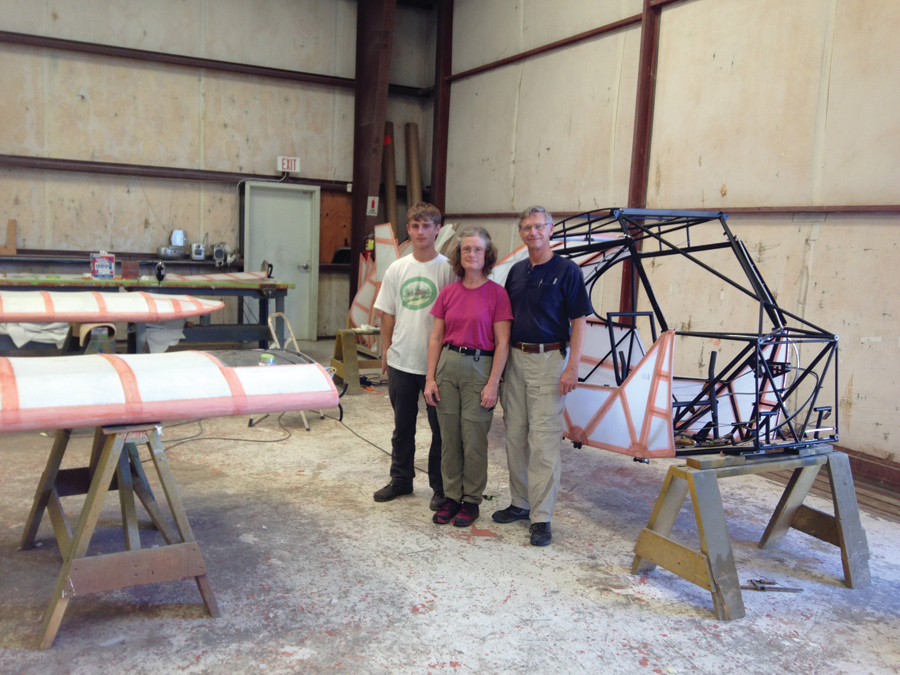
John Paul, Joan, and John Takacs take a short break to pose for a picture in the covering shop at American Legend Aircraft Company.
This was the first time they had built a full-scale aircraft. Although John presently works in the medical profession, he has a background in engineering. He mentioned having specific knowledge and experience in metal work. That, coupled with the fact that “my wife is a human sewing machine,” made John confident the family would be up to a project of this scale. Evidence his assertion was true is that both he and his son built an entire wing in one day. He interjected: “Thus far we’ve had a really great experience.” It was a signal to me he was proud of their achievement.
Finding the Perfect Plane
While working in engineering, John assisted his wife in attending medical school. He later entered medical school too, a passion they shared together. But his flying started as a kid. John recalls taking the bus from New York City to New Jersey to take flying lessons. “I earned enough money to pay for them and got my pilot’s license at age 16,” he said.
Early on, John bought a Cessna 150. He flew this during his medical school years. And for a period of about 10 years, John had a German motorglider. “But I was a Jeep guy. The motorglider was like a Mercedes,” he quipped. “I went to Alton, Wyoming, to visit the Husky factory and had one built to my specifications. Some time afterwards, I got extremely ill, near death, and the Husky was sold.”
After his recovery, John began building balsa wood models with his son. He later successfully got his medical back and started renting planes. “With these two hobbies,” John noted, “it became obvious that we should build a plane.”
His wife nixed the idea of building an airplane at home in the garage, or even in a hangar away from home, as this would keep them away from the house for extended periods. So John began the search for an aircraft kit with a factory assist program.
John met and talked with the owner of Just Aircraft in South Carolina about their Highlander. It seemed the right aircraft for his desires. He toured the factory and was pleased with the owner’s offer to assist with the build. He also talked with CubCrafters, nearby in the Pacific Northwest. According to John, it was too much carbon fiber, too much proprietary design, and materials he expected would lead to costly and difficult maintenance.
He narrowed his decision down to Just and Legend. While the Highlander was optimum for STOL and fun, what John really wanted was a Continental engine. This made the Legend Cub his final choice.
The research was thorough, but “convincing mom took a bit more effort,” stated John. There would be no shed, and no time spent at an airport where he and his son would disappear. Both parents also realized John Paul wouldn’t be at home forever, so the option of building over several years was out, too. There were no other choices, so John decided to just do it. His son’s two-week Easter break was the perfect opportunity to make it happen.
Factory Assistance
The KwikBild program at American Legend is designed to meet the FAA requirement that 51% of the assembly/fabrication be done by amateur aircraft builders. When planning his visit to the factory, John initially budgeted two weeks for pre-assembly of the fuselage, wings, and tail components. This is typically enough time to get the aircraft ready for paint. But the Takacs are pretty crafty, so progress was much faster. John asserts that they did not need any handholding, just a place to start, and off they went.
An example of their craftiness came with the fabric covering work. Juan Zuniga, an experienced technician at American Legend, showed them the normal steps. After the briefing, father and son were ready to proceed and do it themselves.
That’s not to say they didn’t receive help from the Legend Cub staff. John conveyed numerous times that the factory workers are passionate about what they do, and more than willing to share their knowledge and skill.
Sometimes all that was needed was a little simple guidance. For example, John knew what a Cleco was, but never knew how one was used. In four seconds the mystery was solved.
Other problems were more complex. When putting the seat in, John couldn’t get it to fit and was sure it was welded wrong. But it slipped in just fine with the technique demonstrated by a factory technician using a come-along cable puller.
“The factory is dedicated to getting the job done well,” said John. “When building plastic models, you simply fit the pegs in the holes. This is simply not the case when building full-size airplanes.”
He continued, “The KwikBild program made it possible for us to learn about the tools, materials, and techniques necessary to complete the kit. Under the watchful eyes of regular production line workers, and with their help, our Cub is comparable in quality to the factory aircraft, but we were able to add custom touches that make it unique.”
John Paul added to the discussion: “The most amazing thing was the way we were welcomed into the community.” John Paul had assumed they would be put in a corner and handed some tools. Instead, the factory workers really made it feel like home. “This program made it possible for us to build the plane away from home, yet involve the whole family,” he said.
“Doing it this way at the factory also means we’ll be able to fly it soon,” said John Paul excitedly. He recalls flying in the Husky when he was a toddler. More recently, his first seven logged hours were in a 1946 65-hp Cub. His most recent training was in a Cessna 152. At 13 hours he feels he’s ready to solo. He may wait to do this in the Legend Cub. With 100 hp, he imagines there will be a significant difference.
Two Weeks Later
I called John up on a Sunday following their first two weeks of the build. I was expecting they would be taking the opportunity to get caught up on some rest. “Get much work done today?” I asked. John confirmed my suspicion when he said, “No, my son slept late. We are using the day to recoup.”
However, things didn’t entirely come to a halt on this day of rest. John informed me that he met with Darin Hart, owner of American Legend, for a few hours. They did some planning on the next phase of the build. John had selected bigger tires, 8.00×6 vs. the stock 6.00×6, and a Scott 3200-type tailwheel. Together they refined the instrument panel layout and, to John’s surprise, they spent nearly an hour on the aircraft registration paperwork.
Their discussions continued on which assemblies would need work tomorrow. They gathered wingstrut components, expecting primer and paint to take place in their absence. John also made plans to cut metal liners for the baggage compartment. Darin reviewed and confirmed with John that the wings were done and ready for paint. He mentioned the fuselage would get a bit of clean up with a razor and an iron to smooth out excess fabric.
John mentioned that his baggage compartment would be finished out in carbon fiber with the aforementioned metal liners on the sides. Pat Bowers, who’s been working with Darin since the company’s launch, had helped John and John Paul with a turtledeck cabinet in the aft stowage area, suitable for carrying fishing rods.
John was excited to see his ideas for the instrument panel come together. He mentioned that Darin would be cutting the panel on a CNC machine. In its center would be an iPad mini with Garmin GDL 39 3D ADS-B receiver. The Garmin setup includes a moving map, attitude indicator, and synthetic vision. “The glass panel will be flanked by steam gauges,” supplanted John.
Small Trig radio and transponder heads will be mounted in the wingroot. The box for these controls will be behind the panel, but the wingroot mounting allows piloting from the rear seat. John anticipates putting passengers, even young persons, in the front seat. This way he can be pilot-in-command and handle radio switches from the rear seat.
John and Darin also discussed making an elastic sock for the back of the front seat where a second iPad will rest. Its display will mimic that of the forward panel via a wireless Bluetooth connection. John seemed very pleased that Mark Krotky, the resident avionics expert, and Darin worked closely with him on ergonomics for placement of panel items.
John confessed that, before the project began, he assumed “the kit would snap together.” This was found to be unrealistic, and he quickly learned that any airplane requires some mechanical technique by the builder. John and John Paul were prepared and enthusiastic about riding it out. He admits that while some would be happy to watch, they really wanted to be hands-on. “The joy is getting in and doing it,” he explained. “It felt really good to be a part of this build.”
The last day of the two-week program included tailwheel refresher time with Darin and final touches on details. With pre-assembly of the fuselage and wings finished, and the complete aircraft covered, John and John Paul went home to Portland, while the team at American Legend painted the plane, pre-wired and installed the avionics and instruments, and received the engine and prop.
Finishing Up
Returning to Sulphur Springs a few weeks later, John and John Paul began phase two of the KwikBild program, which typically takes seven to 10 days. The first day back, they installed the landing gear system and attached the wings and tail surfaces to the fuselage. A day or so later the engine was installed, and John noted that one of the coolest moments of the entire project was putting on the propeller.
With all tasks completed, the plane was ready for final inspection. In typical fashion, the FAA-authorized inspector thoroughly reviewed the completed Legend Cub. John recalls this lasting two hours before it was pronounced fit to fly.
John’s factory-built Experimental Legend Cub was certified as an ELSA. This means that its construction conforms to the specifications of an SLSA-certified, ready-to-fly Legend Cub. All of the privileges of a Sport Pilot license can be exercised with an ELSA, and the owner can perform routine maintenance and repairs. To sign off on the annual condition inspection, an ELSA owner must pass a 16-hour course.
Legend Cub kits can also be licensed as Experimental/Amateur-Built, with a gross weight of 1750 pounds (vs. 1320 for an ELSA). The test-flight period is 40 hours, and the builder can perform all maintenance, including the annual condition inspection, after receiving the repairman certificate for the aircraft.
With airworthiness certificate in hand, John concluded, “Before becoming a physician, I never completed my initial training as an aerospace engineer. Dreams of being a test pilot or astronaut never matured, and I went on to pursue a medical career.”
After making the first flight in his new Legend Cub, John explained, “Without a doubt, it was the most natural thing for my son to fuel up N167J and for me to test-fly it. I was calm, and the flight was exciting and invigorating. Everything worked just fine, and the plane flew perfectly. My son and I worked extremely long hours, efficiently and well, and I allowed myself a deep sense of satisfaction.”
Darin Hart and production flight test pilot Chuck Olmstead also flew N167J to make sure everything checked out just fine. After the mandatory five-hour local shakedown and a careful re-inspection were complete, John and John Paul loaded their sleeping bags and camping equipment into the Cub and flew the 1700 miles back to Portland.
“The Legend cub can be piloted from the front or back seat, so I was able to allow my student pilot son, John Paul, to fly front seat,” said John. “We made the triumphant landing back home, and our arrival was watched by a very proud mom.”

